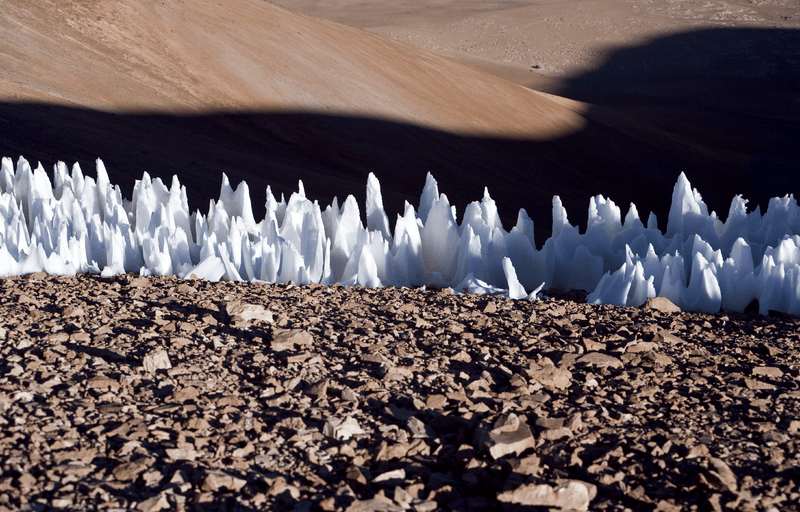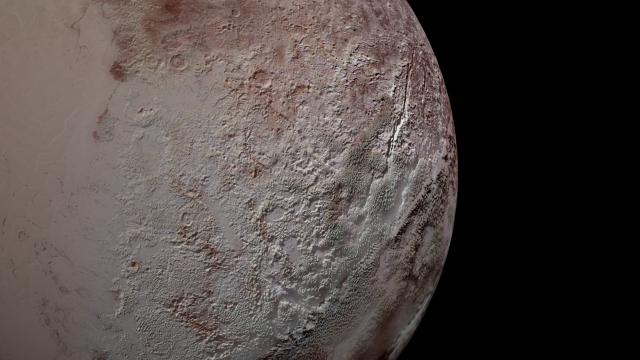When NASA’s New Horizons space probe zipped past Pluto in 2015, it revealed portions of the dwarf planet’s surface were strewn with what could only be described as gigantic blades of ice, many of which extended into the Plutonian sky for hundreds of metres. Finally, after nearly two years of research, a team of scientists think they have figured out the nature of these odd features and how they came to appear on the surface.
Pluto’s bladed terrain as seen from New Horizons during its July 2015 flyby. (Image: NASA/JHUAPL/SwRI)
New research published in Icarus proposes that the bladed terrain of Pluto is the product of a unique kind of erosion that slowly claws away at giant mounds of frozen methane. As Pluto’s climate changed over time, this erosion bit away at these structures, forging them into dramatic crests and sharp divides. The finding shows that Pluto’s surface and atmosphere is far more dynamic (and weirder) than we thought.
These jagged geological ridges — the highest of which reach an astounding 500m — are found at Pluto’s highest altitudes and near the equator. Jeffrey Moore, a research scientist at NASA’s Ames Research Center in California, thought this was an interesting clue, leading him to theorise that the structures first formed on the surface as methane gas froze from the atmosphere. The process is similar to what’s seen on a frosty autumnal morning, but instead of water ice, Pluto features methane ice.
“When we realised that bladed terrain consists of tall deposits of methane ice, we asked ourselves why it forms all of these ridges, as opposed to just being big blobs of ice on the ground,” noted Moore in a statement. “It turns out that Pluto undergoes climate variation and sometimes, when Pluto is a little warmer, the methane ice begins to basically ‘evaporate’ away.”
But on Pluto, methane doesn’t turn into a liquid before it turns into a gas. Recalling your Year 10 chemistry, this process is known as sublimation, where a solid goes directly into a vapour under special circumstances.

Similar features, called penitentes, can be seen at the southern end of the Chajnantor plain in Chile. (Image: ESO/Wikimedia)
Importantly, similar features can be found along Earth’s high altitude equatorial regions, though at a vastly smaller scale. Such terrestrial structures are known as penitentes — snow formations that measure just a couple of metres high, but with a striking resemblance to what’s observed on Pluto.
If Moore is right, this means that Pluto’s bladed terrain is the product of an active surface, one that’s evolving over long periods of time. Millions of years ago, Pluto’s early climatic conditions caused the methane to freeze at high elevations. As time passed, these conditions changed, and the methane structures began to burn off into a gas, creating the giant ice blades we see today.

Maps showing the topography (top) and composition (bottom) of Pluto’s surface. In the top map, the highlighted red region is high in elevation, while the map below shows the composition, where methane is colour-coded in orange. The orange features spread into the fuzzier, lower-resolution data that covers the rest of the globe, hinting that those areas are also high in methane, and therefore likely to be high in elevation. (Image: NASA/JHUAPL/SwRI/LPI)
Interestingly, this latest research is also telling us a bit more about Pluto’s topography. When New Horizons zoomed past Pluto at a distance of 12,500km and at a speed of 52,300km/h, the spacecraft only managed to capture low resolution images of its so-called “far side”, while feverishly searching for methane and other compounds on Pluto using its onboard infrared spectrometer.
Armed with the knowledge that methane likes to form at high elevation surfaces, Moore’s team has produced an updated topographical map of the minor planet. Excitingly, this added information suggests that the bladed terrain also exists on Pluto’s lesser known side. Time to plan another mission!
[Icarus]
